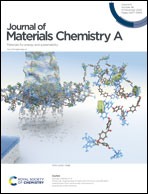Nb-incorporated Fe (oxy)hydroxide derived from structural transformation for efficient oxygen evolution electrocatalysis†
Abstract
Development of new groups of oxygen evolution reaction (OER) electrocatalysts based on transitional metal materials is highly attractive for renewable energy conversion and storage. Here we report a new FeNb (oxy)hydroxide catalyst, which delivered a high OER activity with an overpotential as low as 0.34 V (at 10 mA cm−2). To attain a homogeneous mixing of metal components, niobium was initially incorporated into the framework of iron oxalate dihydrate. The mixed oxalate could be structurally transformed into short-range ordered (oxy)hydroxide, the reactive species for the OER. Incorporation of Nb has been demonstrated to improve the intrinsic OER activity based on Fe species and to accelerate the charge-transfer kinetics across the solid-electrolyte interface. It is also found that strong Fe–Nb interaction can induce the formation of high-valent Fe species. Theoretical calculation results further illustrate the role of NbOx in the OER mechanism, in which Fe serves as the active site and the Nb species can promote the conversion of *OH to *O intermediates to reduce the OER overpotential.



 Please wait while we load your content...
Please wait while we load your content...